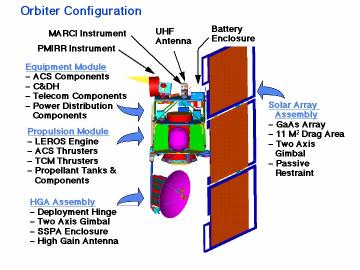Mars Climate Orbiter
Spacecraft Description
The Mars Climate Orbiter is 3-axis stabilized in all mission phases following
separation from the launch vehicle. The primary attitude determination
is via star camera and an inertial measurement unit, and is backed
up by analog sun sensors. Reaction wheels provide primary attitude
control during most mission phases, and are desaturated via RCS
thrusters. Because of IMU lifetime concerns, the IMUs will be
turned off during significant portions of Cruise and Mapping,
and the vehicle operated in all-stellar mode. except during maneuvers.
The RCS thrusters also provide attitude control during Trajectory Correction
Maneuvers,
Mars Orbit Insertion, aerobraking drag pass, Orbital Trim Maneuvers, and safe mode [until rates
are damped, at which point RW control is used]. In all, four
5-lbf thrusters are used for Trajectory Correction Maneuvers and pitch/yaw control. Four
0.2-lbf thrusters are used for roll control. The Orbiter C&DH
uses the RAD6000 processor. The X-band link with Earth employs
Cassini Deep Space Transponders, 15 W RF solid state power amplifiers
(SSPA's), one 1.3 m transmit/receive high gain antenna (HGA),
one transmit-only medium gain antenna (MGA), and one receive-only
low gain antenna. A 10 Watt RF UHF system supports the 2-way
link with the Lander. The 3-panel, single wing solar array (SA)
uses GaAs/Ge solar cells and also functions as the primary drag
brake during aerobraking. The batteries are NiH2 CPV batteries,
while the electrical power electronics are based on the SSTI spacecraft
electronics. The thermal control subsystem is passive, with louvers
to control the temperature of the batteries and SSPA's and combinations
of MLI, Kapton, paints, and dedicated radiators for certain other
components.
 Both thermostatically controlled and computer controlled
heater circuits are used. The Orbiter equipment module (EM) is
a composite truss structure with titanium end fittings and two
Aluminum honeycomb panels with composite face sheets. The solar
array and HGA track the Sun and Earth, respectively, with 2-axis
gimbals. The propulsion subsystem is dual mode, employing a bipropellant
main engine for Mars Orbit Insertion (MOI) and TCM (hydrazine)
thrusters for all other propulsive events. Most subsystem components
are redundant, with critical items cross strapped.
Both thermostatically controlled and computer controlled
heater circuits are used. The Orbiter equipment module (EM) is
a composite truss structure with titanium end fittings and two
Aluminum honeycomb panels with composite face sheets. The solar
array and HGA track the Sun and Earth, respectively, with 2-axis
gimbals. The propulsion subsystem is dual mode, employing a bipropellant
main engine for Mars Orbit Insertion (MOI) and TCM (hydrazine)
thrusters for all other propulsive events. Most subsystem components
are redundant, with critical items cross strapped.
For questions or comments on this website please refer to our list of contacts.


Both thermostatically controlled and computer controlled heater circuits are used. The Orbiter equipment module (EM) is a composite truss structure with titanium end fittings and two Aluminum honeycomb panels with composite face sheets. The solar array and HGA track the Sun and Earth, respectively, with 2-axis gimbals. The propulsion subsystem is dual mode, employing a bipropellant main engine for Mars Orbit Insertion (MOI) and TCM (hydrazine) thrusters for all other propulsive events. Most subsystem components are redundant, with critical items cross strapped.